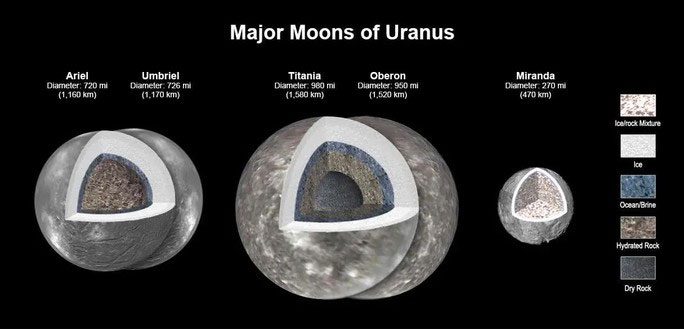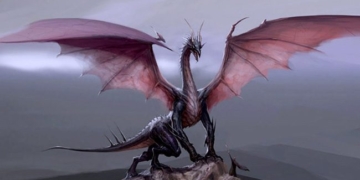In what seems like the desolate regions of the Solar System, scientists have recently discovered four worlds that could potentially harbor warm, life-friendly shelters for extraterrestrial life.
According to SciTech Daily, NASA scientists have reanalyzed an intriguing dataset collected by the Voyager spacecraft duo before they ventured out into interstellar space. As a result, they found something fascinating about four out of the 27 moons of Uranus.
These are Ariel, Umbriel, Titania, and Oberon, four large moons of this distant planet.

Internal structure of Uranian moons – (Photo: NASA).
The region of space around Uranus, the seventh planet in the Solar System, is certainly extremely cold. However, their icy crusts, similar to some of Jupiter’s and Saturn’s moons, could serve as excellent shields to retain a warm subsurface ocean.
A model has been constructed with additional data from other NASA spacecraft that have previously operated near the area or studied similar worlds: Galileo, Cassini, Dawn, and New Horizons.
The results indicate that the four moons Ariel, Umbriel, Titania, and Oberon not only benefit from their icy crusts but their diameters, ranging from 1,160 km to 1,580 km, could allow them to retain heat from radioactive decay in their cores, providing a potential heat source in the rocky mantle, where evidence has been found.
Similar to Earth, this process releases heat to warm the subsurface ocean, keeping the internal water in a warm state.
Moreover, they have the capacity to hold substances that act as antifreeze, such as chlorides, ammonia, and salts, which also exist in Earth’s oceans.
Among the four moons mentioned, models suggest that Titania and Oberon are the most intriguing worlds, with oceans that could be warm enough to support life.
NASA also surveyed another moon, Miranda, but unfortunately, while it possesses some factors that could support a warm subsurface ocean like the other four moons, it lacks the ability to retain its ocean for long. Evidence suggests that it loses heat too quickly and may currently be just an icy body.
This is not the first time that worlds containing potential life have been discovered by scientists.
“When it comes to small celestial bodies – dwarf planets and small moons – planetary scientists have previously found potential evidence of oceans in places like the dwarf planet Ceres, Pluto, and Saturn’s moon Mimas…” stated Dr. Julie Castollo-Rogez from NASA’s Jet Propulsion Laboratory, the lead author of the study.
There are special mechanisms that NASA researchers admit they do not fully understand, making the identification of more worlds similar to Uranus’s four moons extremely valuable.
These findings also guide future NASA missions, especially the missions aimed at searching for extraterrestrial life that they are diligently pursuing.
The research has been published in the scientific journal Geophysical Research: Planets.


















































